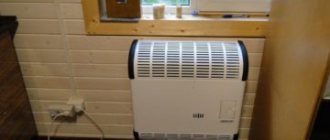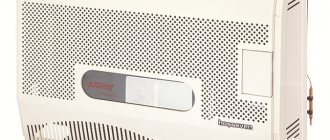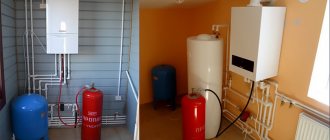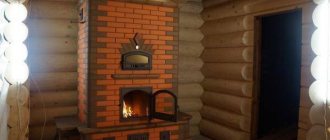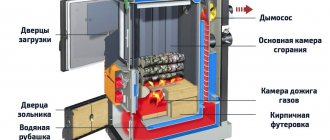A natural gas convector is ideal for low-heat rooms, or for those where there was no central heating initially, such as garage workshops or basements. This device is an excellent solution for people who are sensitive to cold temperatures; they require an increased temperature regime in a certain room, but they should not overheat rooms powered by a general heating system. When chosen correctly, portable heaters can improve the energy efficiency of the heating system as a whole, allowing you to maintain a sanitary temperature throughout the entire house and heat an additional specific room, such as a children's room.
Device, principle of operation
The purpose of the heating unit is to transfer heat to the surrounding space. In the combustion chamber of a gas convector, natural gas burns, heating the heat exchanger, which, in turn, transfers heat to the surrounding space. The principle of heat transfer is based on convection - the natural mixing of gaseous substances with different densities. Gaseous fuel, when burned, transfers thermal energy to the finned heat exchanger. The air, in contact with the surface of the heated metal, heats up and rises, making room for a new portion of cold air.
Flaws
All of the above belongs to the category of advantages of gas convectors. Next we will look at the shortcomings. All pros and cons are such only in the context of this article. For example, if we take the speed of acceleration of a car, then high engine power can be considered a plus, and driver safety and fuel efficiency can be considered a minus.
This is the case with gas convectors. The biggest disadvantage of this device is that you need to drill into the wall to install it. And not just make a hole, but a hole for a coaxial gas outlet. The gas outlet is a special tube in a pipe through which exhaust gases exit, and the fresh air necessary for combustion enters the convector through an external pipe. It is logical to assume that there should be a hole in the wall in the place where the convector is located, and if they are located under every window in every room, imagine how many holes there will be in your house! And these holes cannot be hidden or brought to one place. And remember another hole in the wall for gas supply. A vivid picture of a house appears before your eyes, shrouded in gas pipes and full of holes in the walls. Agree, not a very inspiring sight!
Let's imagine a living room with an area of 30 square meters with two windows. Using a standard heating system, a convector would need to be placed under each window. In the case of gas convectors, this option does not work. We will need to install one convector with increased power in a certain place on the external wall of the room, where there would be optimal conditions for supplying gas there and making a duct for exhaust gases. With this installation there will be no temperature balance in the room. It will be hot in one corner and cold in the opposite. For comfort, you need to place another low-power convector under each window, which immediately doubles the cost of the entire system and the aesthetics of the room. We conclude that this option is inferior to a conventional water heating system.
The gas convector has low inertia. In other words, it heats up very quickly and cools down at the same speed, which can be considered both a plus and a minus, it all depends on how the device is used. In a residential area, of course, this negatively affects the comfort of the temperature regime, but for a garage, workshop or shed, quick heating is a definite plus.
There is one more nuance in a gas convector, which can, in a certain case, be considered a plus or a minus. It has a combustion chamber in which the gas, burning, heats a certain body and a chamber, which then heats the air. For a long service life of the convector, it must use steel that is resistant to fading. It’s good if it uses just such a special steel. But in this case it will not be cheap at all. If it uses cheap steel, then the convector will very quickly fail due to corrosion, burnout, etc. Now, if in a convector the combustion chamber is made of 10 mm cast iron, then such a device will practically last forever.
Structural diagram
The concept of a gas convector is based on the combustion of fuel, which forms a combustible mixture, mixing with air in a gas burner and transferring heat from the heat exchanger to the surrounding air.
Common heater elements:
- A housing that combines component units.
- Gas-burner.
- The combustion chamber.
- Heat exchanger.
- Control system.
Gas heating convectors differ from each other in thermal power, types of combustion chambers, heat exchanger design and monitoring and control mechanism.
Ballu BIGH-3
Photo: https://beru.ru
This model is an ideal option for tourists or fishermen. The relatively light weight of 1.5 kg makes the device mobile and easy to transport. A power of 3 kW at maximum mode will allow you to heat an area of 30 m2. At the same time, fuel consumption is only 200 g per hour. Heating is produced by infrared radiation, which arises from gas heating of a ceramic panel
An important feature of this device is the rotating burner with a grid on legs. Thanks to this function, it can be placed in a horizontal position and the heater can be used as a stove for cooking, which makes the model an indispensable “comrade” when hiking and fishing
A nice bonus is that the kit already includes a 1.5 meter long hose and a reducer.
Gas stove Ballu BIGH-3
Flaws:
relatively short hose
When choosing a gas convector, as you already understand, you should pay attention to such important factors as:
- price
- safety
- heating area
- noise level
- installation specifics
- additional features
By following all the selection standards, you can easily choose the device you need. Enjoy the shopping!
#Top 10
Read us first - add the site to your favorite sources.
Properties
Gas convectors running on natural gas are autonomous heat sources. Some models require a connection to the electrical network for the operation of the control and smoke removal system.
Advantages
- Full autonomy - for convectors with a mechanical control system running on imported liquefied gas.
- Compact dimensions, especially for wall-mounted options. The device does not take up much space and fits organically into the interior of the room.
- The possibility of making the body in a variety of design solutions, for example, in the form of a floor-standing fireplace.
- There is no risk of the system defrosting - no coolant is used in the heating circuit. Ability to start at -50°C.
- The convector is beneficial for periodic use during temporary stays of people. This work schedule is typical for garden houses, dachas, garages, camp sites, etc.
- Operation as a backup heat source for the period of repair work on the main equipment, in case of a temporary loss of electricity or in the event of a break in the supply of main gas.
- The average efficiency of gas convectors is 80-95%. Some models are capable of operating with efficiency up to 97%.
- The economic component allows it to compete with electric analogues.
Flaws
- Uneven heat flow throughout the room. The lowest temperature is at floor level, the highest is near the ceiling. Cold spots form due to furniture.
- The simplest models burn oxygen in a heated room. There is a need for good ventilation.
- Appliances with a closed combustion chamber require the installation of external air supply systems and the construction of a chimney.
- Increased fire and explosion hazard.
- The narrow specialization of the heater is heating the surrounding air, and nothing more. The availability of hot water is provided only by a gas boiler.
- Heating one room. Multiple rooms will require a separate unit or efficient air ventilation.
- Installation becomes more complicated when supplied from the main gas pipeline. The need for the construction of an external chimney.
Fan heater
Before choosing a gas convector, be sure to consider the presence of a fan heater in it. This design element allows you to more evenly and quickly distribute heated air throughout the room. In addition, this function of the device allows you to blow on the heat exchanger, thereby reducing the temperature of the case. This leads to an increase in the service life of the gas convector. This is especially true for high-power units with a capacity of more than 100 kW.
This is interesting: Heat-reflecting screen behind the radiator: how to install it yourself and the advantages of using it
Residential installation
A gas convector for home heating is safe if the operating rules are followed. The danger comes from the working fluid – natural or liquefied gas. Hence a number of restrictions on installation and operation:
- Convectors with an open combustion type are allowed to be installed in private buildings. Installation in multi-storey buildings is prohibited. It is allowed to use the system in an apartment without an external chimney.
- Structures with any type of combustion are allowed for use in low-rise private housing construction.
- It is allowed to use thermal appliances in industrial and civil premises.
- Preparation of documents for the installation of a separate gas convector is simpler than for a water heating boiler.
In any case, the use of equipment requires approval from the gas service of the locality.
Advantages and disadvantages
A gas heater is 50% cheaper to operate than a conventional electric convector, which is a strong argument for its use. It can operate during power outages and reach maximum temperature quickly, almost instantly.
Advantages of a gas convector:
- Portability and mobility, they can be placed in any room, you can take them with you when moving, for example, to the country.
- Efficient, more than 90% of the energy contained in the gas is converted into heat.
- Instant heat transfer. The lower limit for heating output for such devices is 25 MJ/h, which is equivalent to 6 kW of electric heating, so one standard gas convector produces the same amount of heat as three 2 kW electric heaters.
- Low specific costs for the production of a unit of thermal energy, 1 Gcal.
- Modern level of security. The protection system turns off the heater based on an oxygen depletion sensor if its level in the room becomes too low, as well as in the event of a flame breakout or the heater overturning.
- Carbon monoxide protection.
- Automatic temperature maintenance using a thermostat.
Disadvantages of a gas heater:
- There is no chimney, in designs with natural circulation, so emissions from the combustion process flow back into the room.
- They should not be installed in bedrooms, bathrooms or other small or poorly ventilated areas.
- Water vapor from the combustion process can condense on walls and ceilings and cause mold to form.
Gas convector Alpine Air NGS-50F
Selection of thermal equipment
A gas convector, like other heating equipment for the home, contains a number of distinctive features - structural, design, economic and others. The choice is influenced by the area of the heated room, the seasonality of operation, the presence or absence of an electrical network, whether main gas is supplied or whether it will be a liquefied fuel. An important factor is the economic component. That is, the cost of the equipment itself plus heating costs. Correct analysis of parameters and properties will help you choose the required design.
type of instalation
Gas convectors are available in two types - wall-mounted or floor-mounted. The first option has lower power, up to 10 kW. It has a compact size and does not take up much space. It's easier to choose a location for installation. Easy installation. The wall-mounted heater will easily fit into the living area and will not disturb the interior of the room. Belongs to the household series.
The floor version is more massive. Power up to 20 kW or more. The external design is more interesting, the design is more complex. Requires a separate chimney and air supply system from the outside of the building. Consumes electricity. Installed on legs. Suitable for industrial buildings and public premises.
Fuel
The convector is designed for operation with natural methane (the main type of fuel) or liquefied gas - propane. For the latter case, a special adapter is provided.
The use of natural gas is advisable if there is an extensive gas network near the equipment installation point. There is no need to periodically change liquefied fuel cylinders. The option is more effective from an economic point of view.
The use of bottled gas means complete autonomy. This type is beneficial for garden houses, on farms, as a temporary form of heating for the housing of field construction teams, geologists, and expeditions. The downside is periodic trips to get a new portion of fuel.
Combustion chamber view
Closed or open combustion chambers. The first option involves taking air from the street. There, through a coaxial chimney, combustion products are discharged. The second option is more compact, but uses room oxygen. Plus - the design is simpler and cheaper.
REFERENCE. A coaxial chimney is a structure of two pipes nested inside one another. The external circuit is used to supply and simultaneously heat air from the street. The internal circuit removes combustion products.
Heat exchanger material
Gas combustion occurs at high temperatures, up to 500-700°C. Only steel or cast iron can withstand such heat flows.
Steel construction is lighter, easier to manufacture and cheaper. Cast iron is better able to withstand temperature influences. But the material is more difficult to process, the heat exchanger is heavier. The advantage of a cast iron heat exchanger is that its service life is two to three times longer than that of a steel one, up to 50 years. Minus – the cost is 20-30% higher.
Energy dependence
Simple models running on liquefied gas are completely autonomous, excluding the supply of fuel. Network fuel supply makes the operation of equipment dependent on the supplier.
Adding a fan to the system to quickly warm up the room, control units powered by electricity, tie the heater to external energy sources.
Additional options
Adding technical devices increases the cost of the convector, but adds useful functionality:
- The built-in fan reduces the time it takes to warm up the room. This device will come in handy during the cold season.
- An electric impeller in the system for supplying or removing air and combustion products, respectively, increases the efficiency of the equipment. In addition, forced exhaust increases the safety of the convector.
- Electronic control unit. Links the operation of the convector with the set temperature in the room. The timer automatically starts the burner at the set time of day. The system regulates the gas supply and issues a command to ignite or extinguish based on a signal from a temperature sensor in the room. Increases safety by turning off the gas supply in the event of abnormal combustion conditions or emergency situations.
Power calculation
One of the determining factors when choosing heating equipment. Shows the ability to maintain the required temperature to create a comfortable thermal background in the room.
Approximate figures for determining the required thermal efficiency of the convector:
- 1 kW for heating 25-30 m³ of room volume;
- or ~0.1 kW per 1 m² of area.
That is, to heat a 30 m² room you will need a 3 kW convector. In practice, the parameters are set to be 20~30% higher than the nominal ones. This will avoid freezing during severe frosts and will extend the life of the equipment.
Types of gas convectors
Today on the market you can find various designs of convectors operating on main gas, differing from each other:
- By type of material: steel and cast iron.
- By type of installation: wall, floor, ceiling. The latter are used for heating large industrial and commercial facilities.
- By power: low, medium and high. Such devices operate effectively only in separate rooms. The load is selected from the ratio of 1.0 kW per 10.0 m2. It is easy to calculate that for 80 m2 it is necessary to choose a device with a power of 8 kW.
- By type of combustion chamber: open and closed, which differ in the chimney system. For devices of the first type, exhaust gases are removed through a stationary chimney, arranged according to the stove principle in the space between the walls, which requires additional funds for installation. Models of the second option are easier to install. Exhaust air is removed into the atmosphere through a coaxial pipe.
Installation
The fundamental document for installing heating equipment is the operating instructions included with the product. It provides a description and sequence of installation operations.
Peculiarities
- Wooden house. Thermal insulation of wooden structures is required. It will be necessary to make fire breaks to the roof. The surface of the coaxial chimney heats up slightly due to its design features; there is no need to insulate it.
- Distance from the floor. The minimum distance to the base is no less than 10-15cm. This is necessary for efficient supply of cooled air. Increasing the distance will lead to the formation of a lower cold layer, increasing the temperature under the ceiling.
- Location along the walls. It is limited to the point of external supply of the main pipe for a natural fuel convector and the outlet of the coaxial chimney. The use of a balloon option adds freedom to choose the installation location. It is necessary to take into account the location of people and the location of barriers to heat flow in the form of furniture.
- Connection. Gas pipe laying, wiring and connections are carried out by accredited gas service specialists. The connection to the steel pipe is made with a flexible hose.
- Commissioning activities. The presence of representatives of the local gas service is required. Based on the test results, a note is made in the accompanying documentation for the gas converter.
A gas convector for heating a private house or garage is a successful design for temporary residence of people. An additional function is backup heating equipment.
How to choose power
Each heating device, and gas convector too, has a line in its description indicating the recommended heated area. The data is given for “average” insulation and standard ceiling heights (up to 2.7 m). If your room goes beyond these parameters, you need to adjust the power up or down.
Power is one of the first selection criteria
If you need to estimate the power of a gas convector in advance, the calculation is carried out by area: 1 kW of power is taken per 10 square meters. But this is if the insulation is “average” and the ceilings are 2.5-2.7 m. If there are differences, we again adjust in one direction or the other. And one more thing: it is better to take power with a margin of 20-25%. The benefit is double:
- in case of extreme cold you will not freeze;
- the unit will almost never operate at maximum power, which will extend its service life.
If a more accurate calculation is needed: taking into account wall materials, region, room location, etc., you can find information here.
Popular models
Users speak well of the following brands of gas-type convectors:
- Hosseven H.B.S. Floor-standing device with an open combustion chamber. Fuel is mainline or bottled, there is a telescopic gas outlet. It operates quietly, the heat exchanger and combustion chamber are made of steel. The consumption is 0.9 m3/h of main gas and 0.73 m3/h of bottled gas. Thermal power 9 kW, price from $330 (RUB 21,000).
- ATON, Vektor 3. Non-volatile floor module powered by bottled gas. Small size and mobility are advantages; the temperature is automatically maintained up to +18 C. The combustion chamber and heat exchanger are steel, closed. Productivity 3 kW, price from $200 (13,000 rubles).
- Alpine Air model NGS-40. Wall-mounted device with cast iron heat exchanger. It is supplemented with an anti-freeze function, performs self-diagnosis and is equipped with a thermostat. Efficiency 90%, steel body, electronic ignition. Consumption 0.43 m3/hour, power up to 3.5 kW. Price from $330 (21,000 rubles).
When choosing a gas convector with blower, the user should pay attention to the noise level when the fan operates. If the unit is installed in a residential area, excess noise will interfere with rest
However, the presence of artificial traction increases the efficiency of the equipment. Aesthetic appearance, dimensions and fuel consumption are also important.
Gas equipment is considered explosive, so precautions will not hurt. There should be no flammable substances or open flames near the convector
Manufacturers
In recent years, gas converters Danko, Ross and some others made in Ukraine have become very popular. At a low cost, they are quite reliable. Externally, they are far from ideal, but they look neat. If we talk about models that look great, these are Turkish Demrads. There are only good reviews about them in terms of performance characteristics. At the same time, the similar-priced Eskabe is not encouraging, since its exhaust has a very high temperature, which indicates low efficiency.
Approximate prices for one convector using bottled gas in online stores
In general, a fairly large number of companies have normal reviews from owners:
- Danko (Ukraine)
- Ross (Ukraine)
- FEG (Hungary. There are models with a glass door for viewing the flame)
- Demrad (Türkiye)
- Mora (Slovenia)
- Baxi (Italy)
- [email protected] Emax (Hungary)
- Karma (Czech Republic).
There are many other companies on the market, especially many European ones. In Europe, radiator heating is not so widespread, so they heat themselves with “air heaters” using bottled gas. Branded convectors have a high level of equipment safety, but so do their prices...
A heating element
Electric convectors are equipped with various heating elements. The most inexpensive solution is steel products, found in the cheapest appliances. The high temperature of the heating coil (up to +160 degrees) allows the room to quickly warm up. However, spirals of this type have a low degree of safety: phenomena such as the accumulation of dust or accidentally ingress of water can cause the device to catch fire. The popularity of spiral convectors is explained, first of all, by their low cost. Some manufacturers additionally equip the device housing with special fans, which, in combination with a high-temperature coil, increases the heating intensity.
More expensive models are equipped with safe low-temperature coils that heat up only to +100 degrees. Elements of this type have the form of dissipative radiators made of aluminum with a built-in steel pipe. A special heating filament is located inside this tube. Thanks to the aluminum housing, heating efficiency is noticeably increased. In some models, instead of one, two tubes are used, which allows you to adjust the operation of the heating block.
The different degrees of expansion exhibited by aluminum and steel provoke a gradual decrease in the reliability of the connection between the heating tube and the housing. As a result, this can lead to a complete breakdown of the connection between them. As a result, there is a danger of local overheating of the tube and damage to the heating element. Manufacturers of convection equipment are constantly searching for a solution to this problem.
RX-Silence heating devices, developed and patented by NOIROT (France), are particularly unique. The innovative design of these convector boilers lies in the complete tightness of the silumin body, where magnesium powder is used to seal the nichrome heating filament. The expansion coefficient of the materials used has very similar values, which makes it possible to significantly reduce energy consumption and increase the service life of the convector to 15-17 years.

